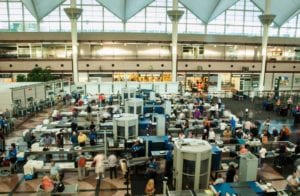These airport security dos and don’ts will help with problems at security checkpoints.

Do get PreCheck:
If you’re in the US, make air travel easier by getting TSA PreCheck. Its lines are generally faster than regular security lines and almost always easier to traverse. You can keep your belt and shoes on and keep your electronic belongings in your carry-on, including your laptop and liquids bag. TSA membership costs less than $16 per year. If you travel internationally, Global Entry, which makes returning to the U.S. faster and easier, costs $20 per year and includes PreCheck.
Obey airport security rules by ensuring you don’t pack banned items and by following the liquids rule exactly.
Don’t pack banned items in your bags:
Virtually every time I’m at the airport, I see passengers having items in their carry-ons being confiscated by airport security, sometimes causing them to be significantly delayed. Often, the confiscation is caused because the traveler isn’t a frequent flier and doesn’t know TSA rules to recognize what’s allowed and what’s banned in their bags. If you’re flying internationally, don’t assume each country’s security rules are identical. Check the rules for each of your destination countries.
Do understand the 3–1–1 liquids rule:
In carry-ons, the TSA liquids rule requires each passenger to limit their liquids, gels and aerosols to 3.4 ounces per container and all containers must be placed into a single quart-sized resealable bag. Larger containers are permitted in checked luggage. There are exceptions to the rule. Passengers may bring medically necessary liquids in their carry-on in excess of 3.4 ounces, but must inform the TSA officer at the security checkpoint of the items. If you’re traveling internationally, remember that each country has its own exceptions list.
Don’t forget to remove keys, loose change and your cellphone from your pockets:
In all security lines, you must remove from your clothing keys, loose change, your cellphone and any other items that will register in a metal detector or full body scanner. That includes cellphone holsters with magnetic closures. I typically wear a warm-up jacket when I fly because so many planes are kept quite cool while aloft and its zippered pockets are a great place to stow my loose items at security. When I get to the x-ray scanner, I place my warm-up jacket in a bin on the conveyor belt. It’s a good theft preventative at security.
Organize your belongings to smoothly follow airport security procedures, ensure your cellphone holding your boarding pass is charged and dress to get through security quickly and easily.

At the airport you’ll need to have your boarding pass and ID, plus passport if traveling internationally. Keep them readily accessible for check-in and security. With boarding passes mostly on cellphones these days, you’ll need it handy too. Have them on your person to keep them secure, not in your bags.
Don’t forget to charge your smartphone:
It’s a rare air traveler that doesn’t use a smartphone while traveling. Most of us use our smartphone for airline boarding passes and it can hold floor plans of unfamiliar airports, assist you to get a new flight if your flight is canceled, etc. If your cellphone isn’t charged, it will be useless and cause serious problems if it’s holding your boarding pass.
Do dress for success:
While you may have TSA PreCheck in the U.S., it won’t help you outside the U.S., if traveling internationally. Wear shoes that are easy to remove and put on at security. The same is true for your belt and pants. I’ve seen some travelers try to get around the belt rule with “airport friendly” suspenders and then argue with TSA agents that they’re okay because they’re metal free, when ordered to remove them. My advice is to forget the suspenders and if required, take off your belt.
Don’t wait to “strip” at airport security:
If you’re wearing outerwear, a hat, jacket, coat, etc., don’t wait to take it off until you get to airport security. Once in the airport, pack your outerwear, if any, in an outside pocket of your bag for easy retrieval as necessary. That way, they’re already off and secured for airport security. They can’t get accidentally damaged from overflowing in a bin on the conveyor belt during x-ray scanning.
Do pack your carry-on strategically:
Particularly if you’re going to have to go through airport security in a regular line, pack so the items that are required to be removed from your bag for separate scanning can be quickly and easily taken from it and put in bins at security.
Glycerine-based soaps and body washes are wonderful, but if you use them before flying and are tested for explosives, you’ll test positive.
Don’t wash with glycerine-based soaps or body washes:
While TSA and most other airport security agencies don’t swab for explosives as often as they used to, they continue to swab periodically, particularly when an item looks suspicious during carry-on x-ray scans. Washing with glycerine-based soaps and body washes will cause you to test positive for explosives if used. That will delay you considerably at airport security checkpoints. I highly recommend that you don’t use one of these products at home before leaving for the airport or during your journey.
Do put your paper boarding pass and ID in your pocket through security:
Well, maybe not in your pocket, but keep them on your person. If I’m traveling domestically in the US, after showing my boarding pass — if not electronic — and ID to TSA security, they go in my pocket. If I’m traveling internationally, my boarding pass, if not electronic, and passport go into a neck pouch.
At airport security, don’t joke about security or talk back or argue with security officials. It can only result in problems and delays.
Don’t joke about bombs or terrorists while at security or talk back to security officials:
It’s not illegal, but joking about bombs, terrorists and airport security at security checkpoints is dumb. It has gotten people detained at airports while security checked them out. Talking back to security officials, even if you’re right, will never work out for you, particularly when you’re running late for your flight. If they confiscate your body wash or makeup, don’t argue. It’s better than missing your flight.
Do put the TSA app on your smartphone:
The TSA app has a searchable “What can I bring?” list on it, as well as links to “AskTSA.” The app also has up-to-date TSA checkpoint time delay information for U.S. airports.

Generally, packaged food and snacks including fruit, health bars and sandwiches can stay in your carry-on bag. But not if it contains a gel, like peanut butter, or a semi-liquid product like yogurt.
Following these dos and don’ts won’t guarantee that you’ll get through airport security with no trouble. But if you don’t follow them, getting through security will likely be more difficult.
READ ALSO:
Airline customer service commitments — are they worthless?
CEO says United Airlines planes are safe
After many years working in corporate America as a chemical engineer, executive and eventually CFO of a multinational manufacturer, Ned founded a tech consulting company and later restarted NSL Photography, his photography business. Before entering the corporate world, Ned worked as a Public Health Engineer for the Philadelphia Department of Public Health. As a well known corporate, travel and wildlife photographer, Ned travels the world writing about travel and photography, as well as running photography workshops, seminars and photowalks. Visit Ned’s Photography Blog and Galleries.



